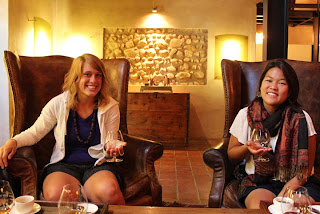Durban
 |
| View from the condo of the Durban beach |
 |
| one of the Victoria/Indian street market alley |
 |
| View from the car on the drive to Addo |
Addo
 |
| B+B/backpackers we stayed at in Addo |
 |
| Elephants drinking at Addo |
 |
| we alighted carefully |
 |
| Zerba, Kudu, warthog and ...I forgot the other |
 |
| they really are this comfortable with people |
 |
| these little moving rocks were all over the place, he was the smallest. |
 |
| Lucie and I enjoying wine at the citrus farm |
Winelands
 |
| view from a winery in Franschhoek |
 |
| Wine cellar in Franschhoek |
 |
| entrance to a winery in Franschhoek |
 |
| Amanda and I tasting |
 |
| Brandy tasting (its a whole different game) |
 |
| Lucie and Sunny at the distillery |
 |
| The only manly thing about the champagne winery |
Cape Town
 |
| Cape of Good Hope |
 |
| penguins |
 |
| Table Top Mountain from V&A Waterfront in Cape Town |
 |
| View from top of Table Top Mountain of Cape Town |




























